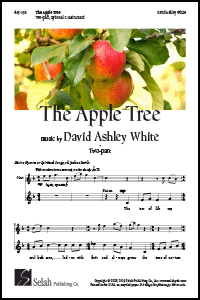|
Composer
David Ashley White
Text anonymous, from Divine Hymns or Spiritual Songs, collection of Joshua Smith, 1784
Voicing
405-158, Two-part, opt. C inst.
405-159, SATB, opt. C inst.
Lectionary usage Advent, Christmas
Price $2.25/$2.00 (U.S.)
Length 3' 00" Released 7/19
Catalog no. 405-158/405-159
Difficulty Easy
|
Order Two-part version now!
Order Two-part PDF download!
Min. of 3
Order SATB version!
Order SATB PDF download!
Min. of 5
Description
This wonderful text has accessible settings by David Ashley White for either two-part choir or SATB with an optional C instrument.
Text
The tree of life my soul hath seen,
laden with fruit and always green:
the trees of nature fruitless be
compared with Christ, the apple tree.
His beauty doth all things excel:
by faith I know, but ne'er can tell
the glory which I now can see,
in Jesus Christ, the apple tree.
For happiness I long have sought,
and pleasure dearly I have bought:
I missed of all, but now I see
'tis found in Christ, the apple tree.
I'm weary with my former toil,
here I will sit and rest awhile:
under the shadow I will be,
of Jesus Christ, the apple tree.
This fruit doth make my soul to thrive,
it keeps my dying faith alive;
which makes my soul in haste to be
with Jesus Christ, the apple tree.
--Anonymous, from Divine Hymns or Spiritual Songs, collection of Joshua Smith, 1784
.
|
|
 



Review
"White furnishes another original melody for familiar words in this eloquent anthem. The instrumental part is marked as optional, yet it does much to enhance the effect of the piece. In a pinch, the line could be played on a solo organ stop if no instrumentalist is available. The opening phrase of the tune outlines an octave from the fifth scale degree below tonic to above, then it continues up to a flattened third. These two elements together give a slight suggestion of the Wexford Carol, yet the melody is uniquely David Ashley White's. The sympathetic echoes of the traditional melody merely strengthen the folk like character. Combined voices sing the first verse in unison, then the second verse appears in canon, with the upper voices following and employing some slight rhythmic alterations to keep the mixed-meter tune aligned between the parts. True harmony appears in the third verse, although it slips in and out of a unison line, creating the feeling of the harmony emerging. A new melody appears in the fourth verse ("I'm weary with my former toil…"), effectively heightening the impact of the words. The fifth verse returns to the main tune with a descant above. As the piece closes, echoes in the lower voice bring a calming sense of closure. With only moderate demands, this anthem would suit all but the most beginning of treble choir programs. An alternate arrangement of the anthem for SATB choir (catalog number 405- 159) is also available. The obbligato line is somewhat different in the full choir version, and White accommodates the larger texture with a few alterations. As such, the two versions could not be sung simultaneously, and both are worthy additions to the choral repertoire." -AAM Journal, April 2021 |



